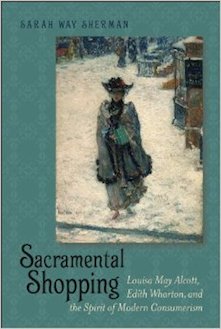By Katy Sternberger
As part of the series called “Becoming Modern: New Nineteenth-Century Studies,” Sarah Way Sherman adds value to the field of literary criticism with Sacramental Shopping: Louisa May Alcott, Edith Wharton, and the Spirit of Modern Consumerism. Her book presents a unique argument about the ways in which moral traditions collided with emerging ideas of modern consumerism. Little Women (1868) and The House of Mirth (1905) are rarely analyzed together, but Sherman uses a religious lens to offer new interpretations on the struggle to create identity and define one’s values amid societal change.
In her introduction, Sherman first analyzes the painting on the book cover, Street Scene, Christmas Morn by Childe Hassam, which sets the stage for her reading of the two novels. The portrait depicts a well-off woman walking with a turquoise package, widely recognized as a box from Tiffany and Co.—that particular color blue became a symbol of affluence. Instead of the focus being on Christmas morning, the focus rests on the box, literally in the center of the painting, and the consumerism it promoted.
Alcott and Wharton used the novel as a means to document a changing American culture, one that grew less reliant on Protestantism for a sense of self and more dependent upon society and material goods to create an identity for oneself. Both novels suggest how materialism and affluence affect the identity of people, particularly young women. In the case of Little Women, Alcott takes an idealistic approach in portraying how women might resist what Sherman calls “the seduction of the marketplace.” However, a generation later, The House of Mirth depicts a much more realistic and dismal outlook of materialism in society.
Relying upon “sacramental shopping” proves dangerous to one’s inner happiness—resulting in the ultimate destruction of Wharton’s protagonist, Lily Bart. Sherman explains, “Evoking the Protestant belief that true identity and salvation are founded on one’s inner relationship to God, Alcott and Wharton both stress the failure of fashionable consumer goods to deliver the happiness they promise.”
Sherman discusses how the novels’ women receive differing forms of guidance during their development. For instance, in Little Women, the March sisters look up to their mother for direction in order to navigate the moral quandaries of society; however, Lily Bart in The House of Mirth has no such model. Instead, she is raised exclusively on the principles of social standing. Whereas Alcott’s characters depend upon idealism to help them cope with the temptations of materialism, Sherman argues, Wharton’s characters find themselves constantly in conflict between the “consumer ‘Catholic’ and the upright Protestant.”
In Sacramental Shopping, fashion equates to Catholicism because, just as Catholic worshippers depend upon the rituals of the priest to confer grace, fashion confers happiness and identity by spending money on clothes. What determines “moral maturity” is the inner state of the worshipper or the shopper during the sacrament, Sherman says. To illustrate, Alcott’s characters must learn to remember that happiness and identity do not come from goods themselves; goods do not signify anything by themselves. Meanwhile, Lily Bart sinks into addiction and cannot find the “domestic happiness” that the March sisters achieve.
Sherman draws upon a wealth of source material, even including extended notes on the publisher’s website. Sacramental Shopping is a well-researched and stimulating new reading of two seemingly unrelated novels; we discover that Little Women and The House of Mirth had a lot to say—and still do—about morals and materialism in American culture.
Katy Sternberger (ΦBK, University of New Hampshire, 2012) is a writer, editor, and researcher. After graduating from the English/journalism program at the University of New Hampshire, she is now pursuing her master’s degree in archives management at Simmons College.




